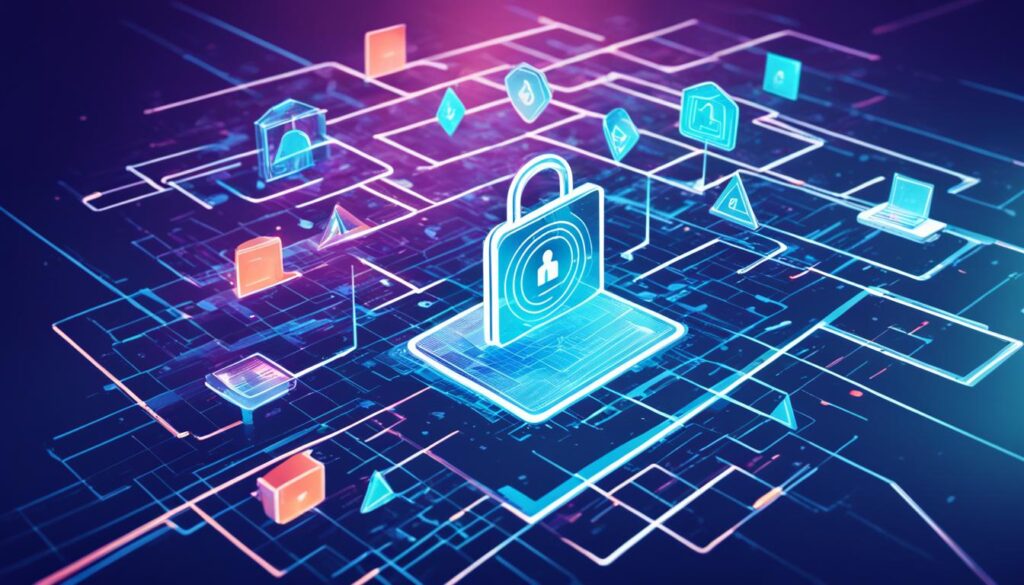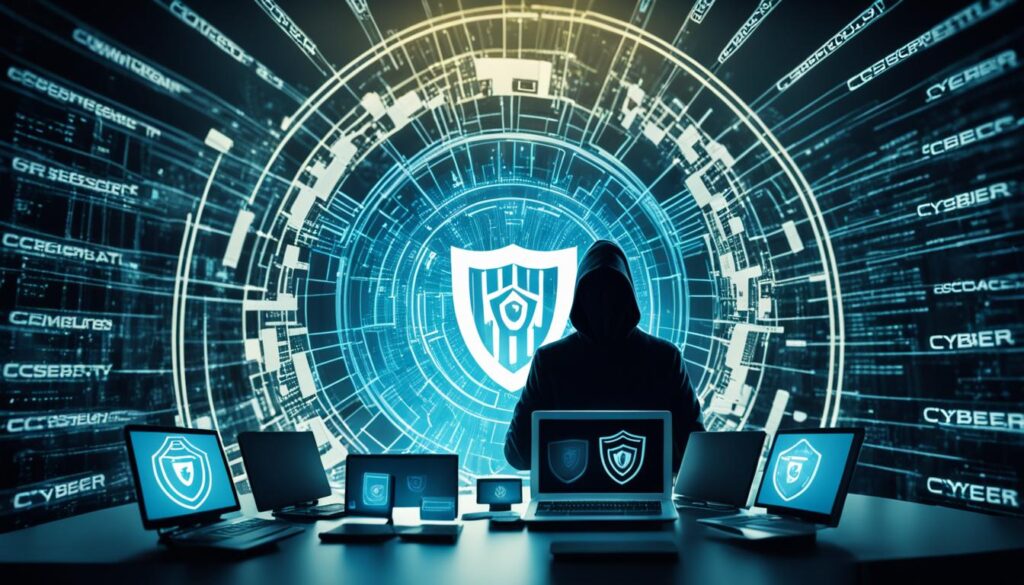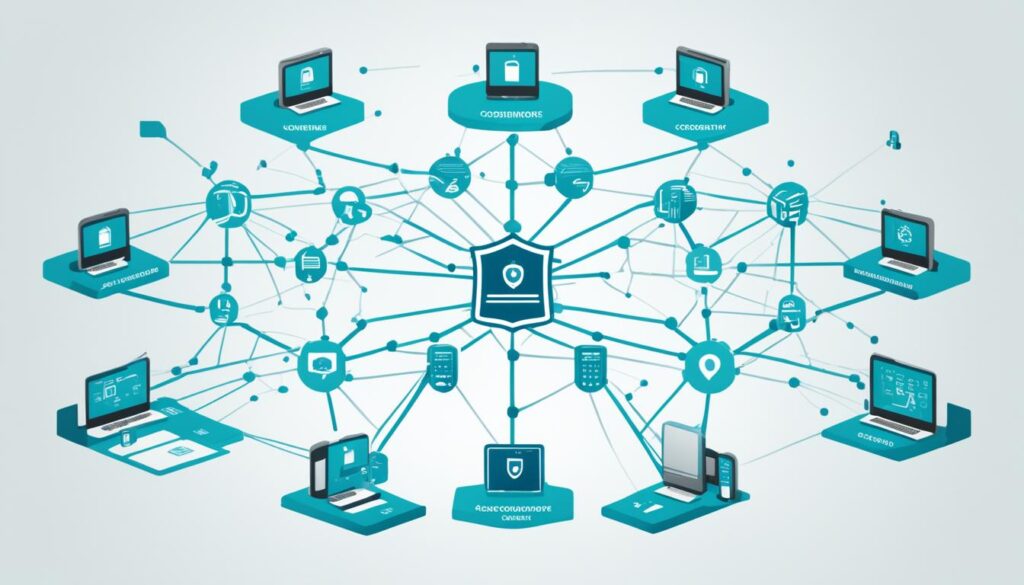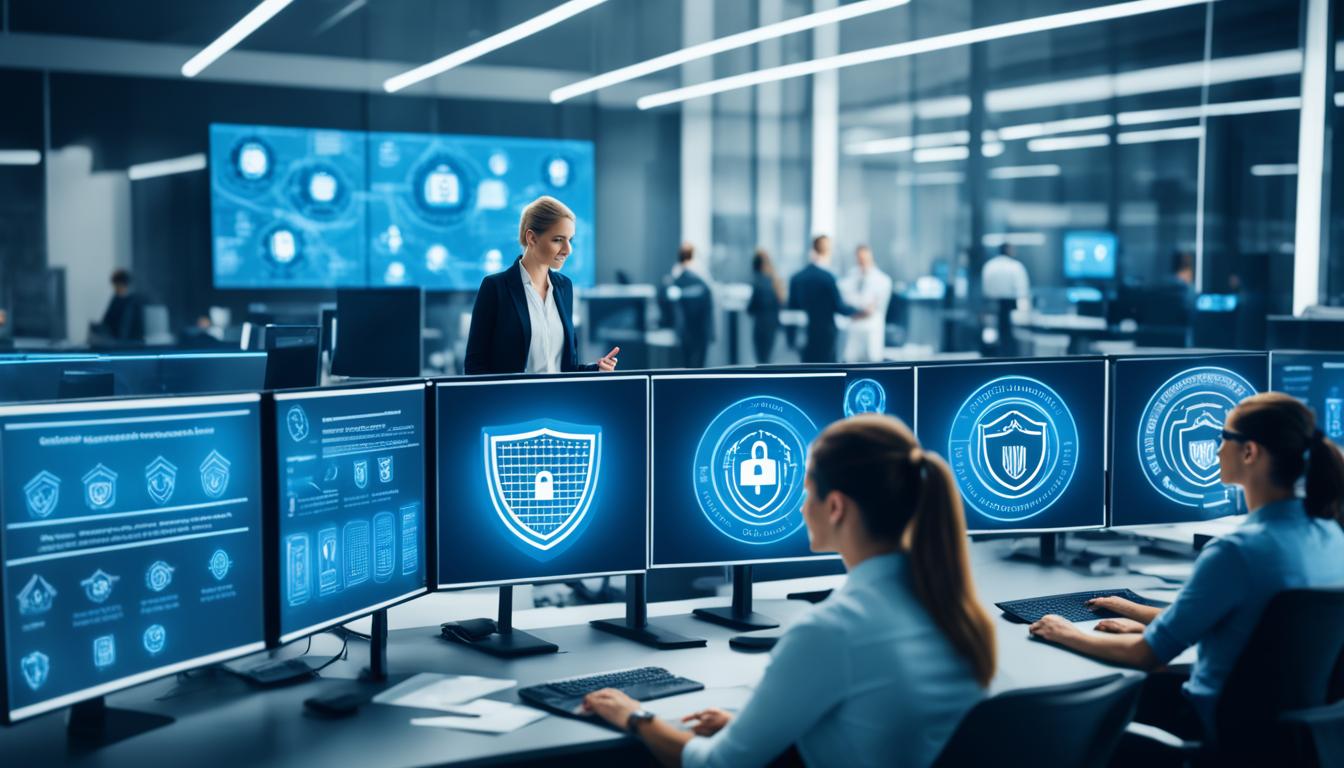Cybersecurity is a critical aspect for government agencies to protect sensitive data and ensure the robust protection of information. With the increasing frequency and sophistication of cyber threats, it is crucial for government agencies to prioritize cybersecurity measures. By implementing comprehensive cybersecurity practices, government agencies can safeguard their systems, maintain public trust, and uphold national security.
Government cybersecurity involves defending against various cyber threats, including unauthorized access, data breaches, and information theft. It encompasses the implementation of robust security measures, adherence to best practices, and continuous monitoring to detect and mitigate potential risks.
In this article, we will provide an overview of the essential cybersecurity measures that government agencies should consider to enhance their security posture and protect against cyber threats. From understanding CISA’s Cyber Essentials to improving network security and ensuring a secure digital workplace, we will explore the key elements of government cybersecurity.
Key Takeaways:
- Cybersecurity is crucial for government agencies to protect sensitive data and maintain national security
- Implementing comprehensive cybersecurity practices is essential for safeguarding systems
- CISA’s Cyber Essentials provides actionable insights for building a culture of cyber readiness
- Key elements of government cybersecurity include protecting systems and data, ensuring a secure digital workplace, and having a robust crisis response plan
- By prioritizing cybersecurity measures, government agencies can effectively mitigate cyber risks and safeguard critical information
Understanding CISA’s Cyber Essentials
CISA’s Cyber Essentials is a comprehensive guide designed to assist leaders of small businesses and local government agencies in strengthening their cybersecurity practices. By following these essential guidelines, organizations can enhance their cyber readiness and protect their digital assets. Let’s explore the key components of CISA’s Cyber Essentials.
The Cyber Essentials Starter Kit
CISA’s Cyber Essentials Starter Kit lays the foundation for building a culture of cyber readiness. It provides leaders with the basic knowledge and tools necessary to mitigate cyber risks and safeguard their organizations. The kit covers a range of topics, including:
- Understanding common cybersecurity threats
- Implementing cybersecurity best practices
- Creating a cybersecurity plan
- Training employees on cybersecurity awareness
By utilizing the Cyber Essentials Starter Kit, organizations can establish a strong security posture and proactively defend against cyber threats.
The Cyber Essentials Toolkits
In addition to the Starter Kit, CISA offers Cyber Essentials Toolkits that break down essential cybersecurity practices into actionable steps. These toolkits cater to different roles within an organization, providing specific guidance tailored to IT professionals and C-suite executives.
The toolkit for IT professionals focuses on technical aspects of cybersecurity, such as:
- Implementing secure configurations for hardware and software
- Developing secure email and web browser settings
- Ensuring application integrity and patch management
- Establishing data backup and restoration capabilities
On the other hand, the toolkit for C-suite executives emphasizes strategic decision-making and governance, including:
- Understanding cyber risk management principles
- Leading investment in cybersecurity initiatives
- Establishing partnerships with government agencies and industry
partners - Developing cybersecurity policies and incident response plans
By breaking down the essentials into these toolkits, CISA enables organizations to address cybersecurity from a holistic perspective, covering both technical and strategic aspects.
Alignment with the NIST Cybersecurity Framework
CISA’s Cyber Essentials aligns closely with the National Institute of Standards and Technology (NIST) Cybersecurity Framework, serving as a valuable starting point for organizations seeking to achieve cyber readiness. The NIST Framework provides a set of industry best practices and standards that organizations can adopt to improve their cybersecurity posture.
By incorporating the principles and recommendations outlined in CISA’s Cyber Essentials and NIST’s Cybersecurity Framework, organizations can establish a robust cybersecurity foundation and enhance their resilience against cyber threats.
To summarize, CISA’s Cyber Essentials offers a comprehensive roadmap for organizations to enhance their cyber readiness. The Starter Kit and Toolkits provide actionable insights and guidance, covering both technical and strategic aspects of cybersecurity. By aligning with the NIST Cybersecurity Framework, organizations can leverage proven industry best practices to protect their digital assets and maintain a strong security posture.
| Cyber Essentials Starter Kit | Cyber Essentials Toolkits | |
|---|---|---|
| Focus | Basics of building a culture of cyber readiness | Actionable steps for IT professionals and C-suite executives |
| Topics Covered |
|
IT Professionals:
C-Suite Executives:
|
| Alignment | Foundation for cyber readiness | Further guidance based on specific roles and responsibilities |

Essential Elements of Cyber Readiness
Building a Culture of Cyber Readiness involves six essential elements. As a leader, it is essential to drive cybersecurity strategy, investment, and culture. This includes leading investment in basic cybersecurity, determining operational dependence on IT, and building relationships with sector partners and government agencies. Development of cybersecurity policies and collaboration with IT is crucial. Additionally, developing cybersecurity awareness among staff, leveraging basic cybersecurity training, and maintaining inventories of hardware and software assets are important aspects of cyber readiness.
Element 1: Cybersecurity Strategy
Establishing a robust cybersecurity strategy is key to protecting government agencies from cyber threats. Leaders should develop a comprehensive plan that addresses potential risks and outlines proactive security measures. This strategy should align with industry best practices, regulatory requirements, and the specific needs of the agency.
Element 2: IT Policies
Implementing effective IT policies is crucial for fostering a culture of cyber readiness. These policies should cover areas such as user access management, data classification, password hygiene, third-party vendor management, and incident response. Regular updates and training on IT policies ensure that employees are aware of their responsibilities and adhere to cybersecurity best practices.
Element 3: Cybersecurity Training
Investing in cybersecurity training is essential to equip employees with the knowledge and skills needed to identify and respond to cyber threats. Training programs should cover topics such as phishing awareness, secure browsing, password management, and social engineering. Regular training sessions and awareness campaigns help reinforce good cybersecurity practices throughout the organization.
Element 4: Security Configurations
Configuring systems and applications with robust security settings is vital to protect against cyber attacks. This includes implementing encryption, enabling firewall protection, installing and updating anti-malware solutions, and controlling user privileges. Regular audits of security configurations help identify vulnerabilities and ensure compliance with industry standards.
Element 5: Network Inventory
Maintaining an accurate inventory of hardware and software assets is critical for effective cybersecurity. This involves documenting all devices, applications, and network connections within the agency’s infrastructure. Regular audits of the inventory help identify unauthorized or outdated assets that could pose security risks.
Element 6: Continuous Monitoring and Improvement
Cyber readiness is an ongoing process that requires continuous monitoring and improvement. It is important to establish mechanisms for monitoring and analyzing network traffic, detecting anomalies, and responding to security incidents. Regular vulnerability assessments and penetration testing help identify weaknesses and prioritize remediation efforts.
By implementing these essential elements of cyber readiness, government agencies can enhance their cybersecurity posture and better protect their sensitive data and critical systems.

Protecting Systems and Data
Protecting critical assets and applications is a fundamental aspect of cybersecurity for government agencies. By implementing robust security measures, agencies can safeguard their systems and data against potential threats. Here are some essential practices to consider:
Maintaining Inventories
Having a comprehensive inventory of hardware and software assets is crucial for effective cybersecurity management. This enables agencies to track and monitor their systems, ensuring that all assets are accounted for and properly secured.
Leveraging Automatic Updates
Regularly updating software and operating systems with the latest patches and security fixes is essential for protecting against vulnerabilities. By leveraging automatic updates, agencies can ensure that their systems are equipped with the latest security measures.
Implementing Secure Configurations
Configuring systems with secure settings is vital to prevent unauthorized access and mitigate potential threats. By following industry best practices and security guidelines, agencies can create a robust defense against cyber attacks.
Securing Email and Web Browser Settings
Email and web browsers are commonly used tools that can be vulnerable to cyber threats. Implementing secure configurations and regularly updating settings can help protect against phishing attacks, malware, and other forms of cyber threats.
Creating Application Integrity Policies
Ensuring the integrity of applications is crucial for preventing unauthorized access and maintaining data confidentiality. By implementing strict policies that verify the authenticity and integrity of applications, agencies can establish a secure environment for their critical operations.
Establishing Regular Automated Backups
Data backup is essential for mitigating the impact of data loss or system failures. By establishing regular automated backups, agencies can ensure that their data is protected and can be easily restored in the event of an incident.

By incorporating these practices into their cybersecurity strategy, government agencies can enhance the protection of their systems and data, minimizing the risk of cyber threats and ensuring the continuity of their operations.
Ensuring Secure Digital Workplace
The digital workplace plays a critical role in government agencies, but it must also be secure to prevent unauthorized access and protect sensitive information. In this section, we will explore essential measures to ensure a secure digital workplace.
Maintaining Inventories of Network Connections
Keeping track of network connections is crucial for understanding the organization’s infrastructure and identifying potential vulnerabilities. By maintaining inventories of network connections, government agencies can proactively monitor and secure their network infrastructure.
Implementing Multi-Factor Authentication
Multi-Factor Authentication (MFA) adds an extra layer of security to user accounts by requiring additional verification beyond passwords. By implementing MFA, such as biometric authentication or one-time passwords, government agencies can significantly reduce the risk of unauthorized access.
Granting Access Control Based on Need-to-Know
Access control is a fundamental aspect of cybersecurity. Government agencies should implement access control policies that allow employees to access only the information and systems necessary for their roles. By granting access based on the principle of need-to-know, agencies can minimize the potential security risks associated with unauthorized access.
Using Unique Passwords for User Accounts
Weak or reused passwords pose a significant threat to cybersecurity. It is crucial to enforce the use of unique and complex passwords for user accounts. Implementing password policies that require periodic password changes can further enhance security.
Developing IT Policies and Procedures
IT policies and procedures provide a framework and guidelines for managing changes and ensuring consistency in security practices. By developing and regularly updating IT policies, government agencies can establish clear guidelines for employees and maintain a secure digital workplace.
Ensuring a secure digital workplace requires a holistic approach that combines network security, authentication mechanisms, access control, and password management. By implementing these measures and adhering to well-defined IT policies, government agencies can significantly enhance their cybersecurity posture.

Conclusion
Enhancing cybersecurity for government agencies is vital to protect sensitive data and maintain national security. By implementing CISA’s Cyber Essentials and following the essential elements of cyber readiness, government agencies can establish a strong security posture.
Protecting systems and data is a critical aspect of government cybersecurity. By maintaining inventories of hardware and software assets, implementing secure configurations, and establishing email and web browser security measures, agencies can reduce the risk of unauthorized access and data breaches.
Furthermore, ensuring a secure digital workplace is essential. This can be achieved through network connections inventories, multi-factor authentication, access control based on need-to-know, and the use of unique passwords for user accounts. Additionally, the development of IT policies and procedures to manage changes in user status helps to ensure a safe and secure work environment.
In conclusion, by prioritizing cybersecurity measures and implementing state-of-the-art solutions, government agencies can effectively mitigate cyber risks and safeguard critical information. With the ever-evolving cyber threats, it is crucial for agencies to stay vigilant and adopt a proactive approach in protecting their systems, data, and overall digital infrastructure.
FAQ
What is CISA’s Cyber Essentials?
CISA’s Cyber Essentials is a guide that provides actionable insights into implementing cybersecurity practices for small businesses and local government agencies. It aligns with the NIST Cybersecurity Framework, serving as a starting point for cyber readiness.
What are the essential elements of cyber readiness?
The essential elements of cyber readiness include driving cybersecurity strategy and culture, developing cybersecurity policies, collaborating with IT, raising cybersecurity awareness, and maintaining inventories of hardware and software assets.
How can government agencies protect their systems and data?
Government agencies can protect their systems and data by maintaining inventories, leveraging automatic updates, implementing security configurations, removing unauthorized hardware and software, securing email and web browser settings, creating application integrity policies, and establishing regular automated backups.
How can government agencies ensure a secure digital workplace?
Government agencies can ensure a secure digital workplace by maintaining inventories of network connections, implementing multi-factor authentication, granting access based on need-to-know, using unique passwords for user accounts, and developing IT policies and procedures to manage changes in user status.
Why is enhancing cybersecurity important for government agencies?
Enhancing cybersecurity is important for government agencies to protect sensitive data and maintain national security. By prioritizing cybersecurity measures, government agencies can effectively mitigate cyber risks and safeguard critical information.








